
Concept explainers
Name the following:

(a)
Interpretation:
Name of the given compound should be identified.
Concept introduction:
Nucleotide is a compound consisting of a nucleoside linked to a phosphate group and they form the basis structural unit of nucleic acid like DNA.
The number of different possible codons using four nucleotides is
Nucleosides are composed of nitrogenous base and sugar. The name of nucleiside ends with ine .
The pentose sugar is either ribose in ribonucleosides or 2-deoxyribose in deoxyribonucleiosides.
A base is nitrogen containing heterocyclic compound which is found in DNA and RNA.
Nucleotide is a compound consisting of a nucleoside linked to a phosphate group and they form the basis structural unit of nucleic acid like DNA.
Answer to Problem 19P
Name for give molecule is
Explanation of Solution
Given structure of compound is,
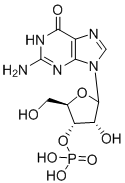
Given compound is a nucleotide because it contains a pentose sugar, phosphate group and a nitrogen base.

And the name of the compound is
(b)
Interpretation:
Name of the given compound should be identified.
Concept introduction:
Nucleotide is a compound consisting of a nucleoside linked to a phosphate group and they form the basis structural unit of nucleic acid like DNA.
The number of different possible codons using four nucleotides is
Nucleosides are composed of nitrogenous base and sugar.
The pentose sugar is either ribose in ribonucleosides or 2-deoxyribose in deoxyribonucleiosides.
A base is nitrogen containing heterocyclic compound which is found in DNA and RNA.
Nucleotide is a compound consisting of a nucleoside linked to a phosphate group and they form the basis structural unit of nucleic acid like DNA.
Answer to Problem 19P
Name for given molecule is Cytidine-5’-diphosphate.
Explanation of Solution
Structure of the given compound is,
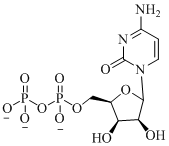
Given compound is a nucleotide because it contains a pentose sugar, phosphate group and a nitrogen base.
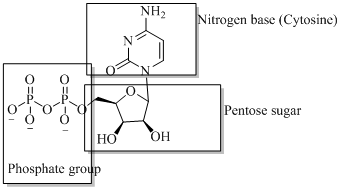
Therefore the name of the compound is Cytidine-5’-diphosphate.
(c)
Interpretation:
Name of the given compound should be identified.
Concept introduction:
Nucleotide is a compound consisting of a nucleoside linked to a phosphate group.and they form the basis structural unit of nucleic acid like DNA.
The number of different possible codons using four nucleotides is
Nucleosides are composed of nitrogenous base and sugar.
The pentose sugar is either ribose in ribonucleosides or 2-deoxyribose in deoxyribonucleiosides.
A base is nitrogen containing heterocyclic compound which is found in DNA and RNA. Nucleotide is a compound consisting of a nucleoside linked to a phosphate group.and they form the basis structural unit of nucleic acid like DNA.
Answer to Problem 19P
Name of the given molecule is 2’-deoxyadenosine-5’-monophosphate.
Explanation of Solution
Structure of the given compound is,
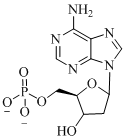
Given compound is a nucleotide because it contains a pentose sugar, phosphate group and a nitrogen base.
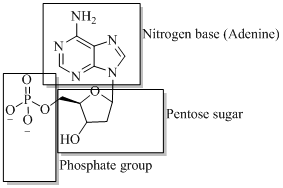
Therefore the name of the compound is 2’-deoxyadenosine-5’-monophosphate
(d)
Interpretation:
Name of the given compound should be identified.
Concept introduction:
Nucleotide is a compound consisting of a nucleoside linked to a phosphate group.and they form the basis structural unit of nucleic acid like DNA.
The number of different possible codons using four nucleotides is
Nucleosides are composed of nitrogenous base and sugar.
The pentose sugar is either ribose in ribonucleosides or 2-deoxyribose in deoxyribonucleiosides.
A base is nitrogen containing heterocyclic compound which is found in DNA and RNA.
Nucleotide is a compound consisting of a nucleoside linked to a phosphate gro0`up.and they form the basis structural unit of nucleic acid like DNA.
Answer to Problem 19P
Name of the given compound is 2’-deoxythymidine.
Explanation of Solution
Structure of the given compound is,
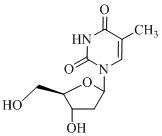
Given compound is a nucleoside because it contains a pentose sugar and a nitrogen base.
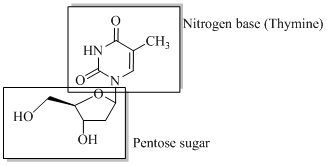
Therefore the name of the compound is 2’-deoxythymidine
Want to see more full solutions like this?
Chapter 26 Solutions
Organic Chemistry
- Give the IUPAC name for this compound Hydrocarbon Condensed Formulas Hint C2H5 CH2CH3 expand that in all the formula Part A: (CH3)2CHCH(C2H5)CH2CH2CH3 Give the IUPAC name for this compound. Part B: CH2=C(C2H5)CH2CH2CH3 Give the IUPAC name for this compound. Part C: (CH3)2C=CHC(C2H5)=CH2 Give the IUPAC name for this compound. Part D: CH3C=CCH(C2H5)2 Give the IUPAC name for this compound. Part E: (CH3)3CC=CCH2CH=C(CH3)2arrow_forwardSelect/ Match the correct letter from the image below for the IUPAC names given below: A B C D 3 E F G H K L Part 1. 4-methylheptane For example.mmmm Answer Letter H _for part 1 Part 2. 2,4-dimethylhexane Part 3. 2,3-dimethylpentane Part 4. 2,2-dimethylhexane Part 5. 2-ethyl-1,1,3,3-tetramethylcyclopentane Part 6. 3-ethyl-2-methylpentanearrow_forwardCan u show the process as to how to get these?arrow_forward
- Sketch the expected 'H NMR spectra for the following compound. Label all of the H's in the structure and the corresponding signal for the spectra you sketch. Make sure you include the integration value and the splitting pattern for each signal Indicate how many signals you would expect in the 13C NMRarrow_forwardUse IUPAC naming rules to name the following hydrocarbon compounds: CH2-CH3 | a) CH-CH-CH2-CH-CH-CH3 b) | CH2 CH3 | CH3 CH3 \ / C=C H 1 H CH2-CH3 c) d) CH=C-CH3 e) CH3-CH2-CH2-CH=CH-CH3 f) CH2=CH-CH2-CH=CH-CH3 g) CH3-CH2-C = C-CH2-CH3 h)arrow_forwardQ5 Name the following : a. b. C. d. e.arrow_forward
- 25. Predict the major product of the following reaction. 1 equivalent of each of the starting materials was used. H₂C CH3 CH3 H3C H3C H3C. CH2 + H3C. heat CH3 CH H.C. CH3 H.C H.C CH3 CH CH3 CH3 A B C Earrow_forwardFind chemical structures based on the below information. a) Chemical formula C6H8O Compound is aromatic plus has two 1H NMR peaks that integrated for 3 each that are singlets (it could have more peaks in the 1H NMR b) Chemical Formula: C6H100 Compounds is conjugated 'H NMR has a signal that integrates for 6 and is a doublet IR spectra has a signal at 1730 cm-1arrow_forwardJaslev Propose a synthesis of the following starting from benzene and any other reagents and chemicals. No mechanisms are required. Indicate the condition for each step plus the major product for each step. More than two steps are required. Step 1 Step 2 مہد Brarrow_forward
- Part C: The line formula for another branched alkane is shown below. i. In the IUPAC system what is the root or base name of this compound? ii. How many alkyl substituents are attached to the longest chain? iii. Give the IUPAC name for this compound.arrow_forwardPart D: Draw the Structural Formula for 4-ethyl-2-methylhexane Part E. Draw the Structural Formula for 1-chloro-3,3-diethylpentane (Chloro = Cl)arrow_forwardPart B: The line formula for a branched alkane is shown below. a. What is the molecular formula of this compound? Number of C. Number of H b. How many carbon atoms are in the longest chain? c. How many alkyl substituents are attached to this chain?arrow_forward

 Chemistry for Today: General, Organic, and Bioche...ChemistryISBN:9781305960060Author:Spencer L. Seager, Michael R. Slabaugh, Maren S. HansenPublisher:Cengage Learning
Chemistry for Today: General, Organic, and Bioche...ChemistryISBN:9781305960060Author:Spencer L. Seager, Michael R. Slabaugh, Maren S. HansenPublisher:Cengage Learning ChemistryChemistryISBN:9781305957404Author:Steven S. Zumdahl, Susan A. Zumdahl, Donald J. DeCostePublisher:Cengage Learning
ChemistryChemistryISBN:9781305957404Author:Steven S. Zumdahl, Susan A. Zumdahl, Donald J. DeCostePublisher:Cengage Learning Chemistry: An Atoms First ApproachChemistryISBN:9781305079243Author:Steven S. Zumdahl, Susan A. ZumdahlPublisher:Cengage Learning
Chemistry: An Atoms First ApproachChemistryISBN:9781305079243Author:Steven S. Zumdahl, Susan A. ZumdahlPublisher:Cengage Learning




